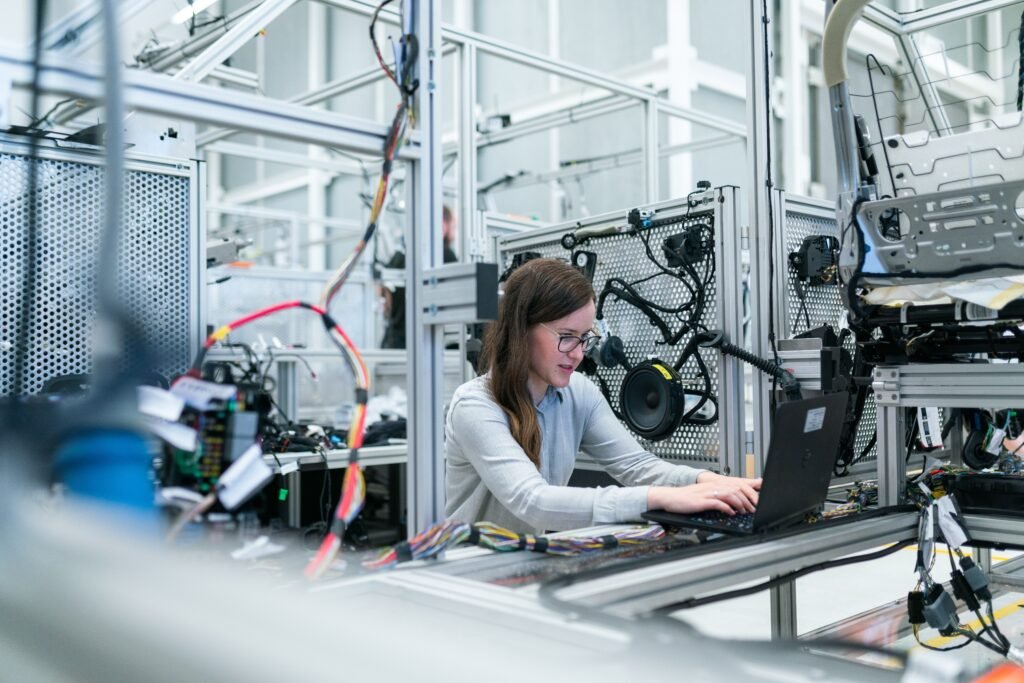In “The Pursuit of Artificial Intelligence: A History of Advancements,” we take a glimpse into the world of AI and its remarkable progression since its inception in 1956. With recent significant developments, AI is steadily permeating various industries, flexing its power in tasks that surpass human capabilities. The ultimate aim is to achieve artificial general intelligence, a self-learning system that outperforms humans in multiple disciplines. However, the road to this goal presents challenges, including job displacement and ethical implications. As AI’s potential to revolutionize sectors like healthcare, climate change, and space exploration becomes evident, some even ponder the impact on human relationships, with the potential assistance of AI in finding romantic partners. Amidst uncertainty about the future, differing opinions on timelines and potential outcomes abound, leaving us intrigued and eager to explore the remarkable journey of AI.
The Beginnings of AI
Artificial Intelligence (AI) has come a long way since its inception in 1956. This field of study focuses on creating intelligent machines that can perform tasks typically requiring human intelligence. The pursuit of AI began with the belief that machines could be created to imitate and even surpass human capabilities.

1956: The Birth of Artificial Intelligence
In 1956, a group of researchers organized the Dartmouth Conference, where AI was officially born as a field of study. The goal of the conference was to explore the idea of designing machines that could mimic human intelligence. This marked a significant milestone in the development of AI, as it brought together some of the greatest minds in the field to share their ideas and research.
Early AI Research and the Dartmouth Conference
Following the Dartmouth Conference, AI research gained momentum. Researchers began exploring various approaches to creating intelligent machines. Early on, AI programs were limited in their capabilities, but they laid the foundation for future advancements. The focus was primarily on solving specific problems, such as chess-playing programs and language translation.
The First AI Programs and Early Successes
One of the earliest successful AI programs was the General Problem Solver (GPS), developed by Allen Newell and Herbert A. Simon in 1957. GPS was a computer program capable of solving a wide range of problems using a set of rules and heuristics. This program showcased the potential of AI and set the stage for further advancements in the field.
Advancements in AI Technology
Over the years, AI technology has advanced significantly, thanks to breakthroughs in machine learning, neural networks, and big data. These advancements have paved the way for the development of sophisticated AI systems capable of tackling complex tasks.
Machine Learning and Neural Networks
Machine learning, a subfield of AI, has revolutionized the way machines learn and make predictions. Instead of explicitly programming rules, machine learning algorithms are trained on large datasets and learn from patterns within the data. Neural networks, inspired by the structure and functioning of the human brain, have played a crucial role in allowing machines to learn and adapt.
Deep Learning and Big Data
Deep learning, a subset of machine learning, focuses on training neural networks with multiple layers. This allows for the processing of vast amounts of data and enables AI systems to make more accurate predictions. The availability of big data, coupled with the computational power to process it, has significantly contributed to the success of deep learning algorithms.
Natural Language Processing and Voice Assistants
Natural Language Processing (NLP) is a branch of AI that deals with the interaction between computers and human language. NLP algorithms analyze and understand human language, enabling machines to process, interpret, and respond to text or speech. This technology has led to the development of voice assistants, such as Siri and Alexa, which can understand and respond to spoken commands.
AI in Industry
AI has found applications in various industries, transforming the way businesses operate and revolutionizing traditional processes. Here are a few examples of how AI is being implemented in different sectors:
AI in Finance
In the financial industry, AI is being used to automate tasks such as fraud detection, risk assessment, and algorithmic trading. Machine learning algorithms analyze vast amounts of financial data to identify patterns and make predictions. This has led to more efficient and accurate decision-making, ultimately benefiting both financial institutions and consumers.
AI in Healthcare
In the healthcare sector, AI is being utilized for various purposes, including medical imaging, diagnosis, and drug discovery. AI algorithms can analyze medical images and identify anomalies that could indicate diseases. Additionally, machine learning models are being developed to predict patient outcomes, customize treatment plans, and assist in medical research.
AI in Manufacturing
In manufacturing, AI is being leveraged to optimize production processes and improve efficiency. AI-powered systems can monitor and analyze data from sensors and machines to detect anomalies, predict maintenance needs, and optimize production schedules. This helps minimize downtime, reduce costs, and enhance overall productivity in the manufacturing industry.
AI in Transportation
The transportation industry is also benefiting from AI advancements. Autonomous vehicles, powered by AI algorithms, have the potential to transform transportation by reducing accidents, increasing fuel efficiency, and improving traffic flow. AI is also being used to optimize logistics and supply chain management, thereby streamlining operations and reducing costs.
Artificial General Intelligence
While AI has made incredible progress, it is still far from achieving the ultimate goal of Artificial General Intelligence (AGI). AGI refers to a self-teaching system capable of outperforming humans in multiple cognitive tasks. This type of AI would possess general intelligence similar to that of humans, allowing it to understand and learn any intellectual challenge.

Definition and Goals of AGI
The definition of AGI can vary, but it generally refers to AI systems that exhibit human-like intelligence across a broad range of tasks. The development of AGI is a major focus for many AI researchers, as it holds the potential to significantly impact various fields, from science and research to everyday life.
Progress and Challenges in Achieving AGI
While significant progress has been made in AI, achieving AGI remains a complex challenge. Developing systems that can learn and adapt like humans in multiple domains is a formidable task. It requires advancements in not only machine learning but also areas such as computer vision, natural language processing, and reasoning.
Implications of AGI for Society
The development of AGI could have profound implications for society. With machines that possess human-like intelligence, there is the potential for job displacement as AI systems can perform tasks more efficiently and accurately than humans. This raises questions about the future of work and the need for new economic systems, such as universal basic income.
Job Displacement and Universal Basic Income
As AI continues to advance, concerns about job displacement arise. AI systems are capable of automating tasks traditionally performed by humans, leading to potential job losses. This shift in the job market raises discussions about the role of governments in providing a safety net, such as universal basic income.
AI and the Job Market
AI has the potential to disrupt numerous industries, resulting in job losses or changes in job requirements. While some tasks may be automated, new jobs and opportunities may arise. The challenge lies in managing the transition and ensuring that individuals are equipped with the required skills to thrive in an AI-dominated job market.
The Need for Universal Basic Income
Universal Basic Income (UBI) is a concept that proposes providing every adult citizen with a regular, unconditional income. The idea behind UBI is to ensure that individuals have a basic level of economic security in a changing job market. As AI continues to advance, a UBI could help alleviate the potential impacts of job displacement.

Implementation Challenges
Implementing a universal basic income is not without its challenges. It raises questions about funding, the impact on work incentives, and potential societal implications. However, proponents argue that it could provide a safety net and promote economic stability in a future where AI plays a significant role in the job market.
AI in Society
AI has the potential to revolutionize various aspects of society, from healthcare to climate change mitigation and space exploration. Here are a few examples of how AI is being applied to these areas:
AI in Healthcare
AI is being used in healthcare to improve patient care, diagnosis, and treatment. From analyzing medical images to predicting patient outcomes, AI algorithms can assist healthcare professionals in making more accurate and efficient decisions. This technology has the potential to save lives and improve overall healthcare outcomes.
AI in Climate Change
Climate change is a global challenge that requires innovative solutions. AI can help by analyzing large datasets and identifying patterns that assist in understanding climate patterns and predicting future changes. Additionally, AI-powered systems can optimize energy usage, monitor environmental factors, and contribute to sustainable practices.
AI in Space Exploration
AI is playing a vital role in space exploration, assisting in tasks such as satellite data analysis, trajectory planning, and autonomous spacecraft operations. By leveraging AI algorithms, space agencies can make more efficient use of resources, increase mission success rates, and gather valuable data for scientific research.
Ethical Implications of AI
As AI becomes more advanced, ethical considerations arise. Questions surrounding AI consciousness, rights, and privacy need to be addressed to ensure the responsible development and use of AI technology.
Can AI Be Conscious?
The question of whether AI can be conscious poses philosophical and ethical challenges. AI systems are programmed to simulate human-like intelligence, but whether they possess subjective consciousness remains a topic of debate. The implications of AI consciousness raise questions of ethical treatment and responsibilities towards these systems.
Rights and Responsibilities of AI
As AI becomes more integrated into society, questions arise regarding the rights and responsibilities of AI systems. Should AI be granted legal personhood or certain rights to protect their interests? Additionally, there is a need to establish guidelines and regulations to ensure the responsible use of AI and prevent misuse or harm.
AI and Privacy
AI systems often rely on vast amounts of personal data to learn and make predictions. This raises concerns about individual privacy and the potential for unauthorized access or misuse of personal information. Striking a balance between the benefits of AI and protecting privacy is crucial to ensure trust and ethical use of AI technology.
Impacts on Human Relationships
AI has the potential to impact human relationships, particularly in the realm of romantic partnerships. The rise of AI assistants and matchmaking algorithms opens up new possibilities and raises questions about the role of AI in human relationships.
AI Assistants and Relationship Advice
AI assistants, with their ability to process and analyze vast amounts of information, can provide relationship advice based on patterns and insights from the experiences of millions of people. While they may not replace human counselors or therapists, AI assistants can offer guidance and support in navigating relationship challenges.
AI in Dating and Matchmaking
Dating apps and matchmaking algorithms that utilize AI are becoming increasingly popular. These algorithms analyze user preferences and behavior to suggest potential matches. While AI can help people find compatible partners, there are concerns about bias in the algorithms and the potential for over-reliance on technology in forming connections.
The Uncertain Future of AI
Despite the remarkable progress in AI, the future remains uncertain. Experts hold varying opinions on the timeline and potential outcomes of AI development.
Predictions and Timeline of AI Development
Experts’ predictions regarding the future of AI development range from cautious optimism to concerns about its potential risks. Some believe that AGI will be achieved within the next few decades, while others argue that it may take much longer or even be unattainable. The timeline and outcomes of AI development continue to be the subject of ongoing debate and research.
Possible Outcomes and Scenarios
The future of AI could unfold in various ways, depending on how it is developed and regulated. Optimistic scenarios envision AI as a tool that enhances human creativity, productivity, and well-being. However, there are also dystopian scenarios that warn of the risks associated with uncontrolled AI development. Striking a balance between innovation and ensuring ethical use will play a crucial role in determining the path AI takes in the future.
In conclusion, AI has come a long way since its birth in the late 1950s. Advancements in machine learning, neural networks, and big data have propelled AI to new heights, allowing it to outperform humans in certain tasks. The pursuit of AGI remains a significant goal, with implications for job displacement, society, and ethical considerations. While AI has the potential to revolutionize industries and benefit society, careful attention must be paid to its ethical implications and potential impact on human relationships. The future of AI remains uncertain, with possibilities ranging from utopian to dystopian scenarios. As AI continues to evolve and shape our world, it is essential to approach its development and implementation with responsibility and consideration for its impact on individuals and society as a whole.






